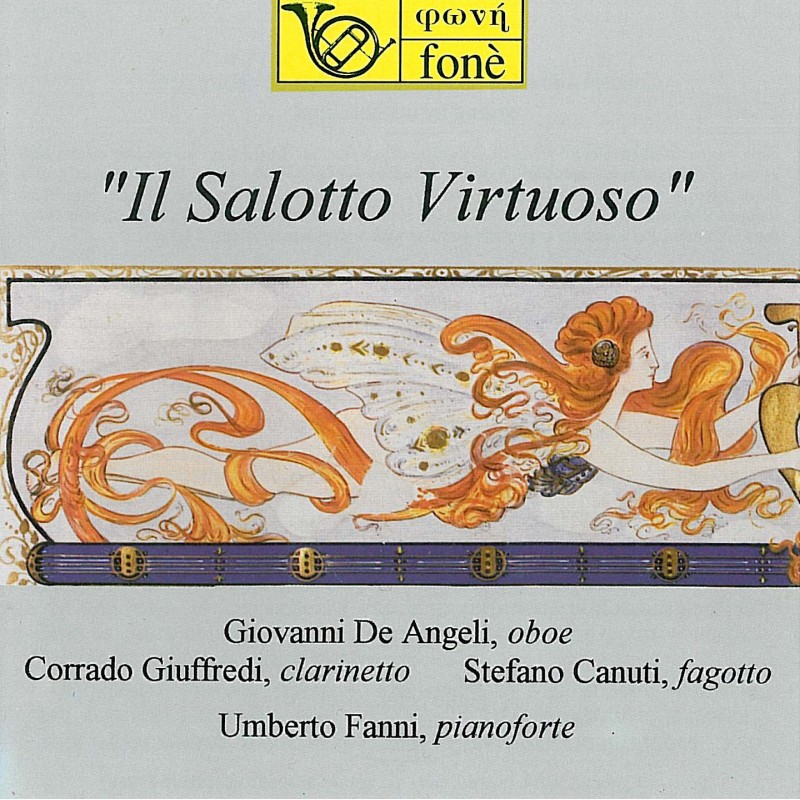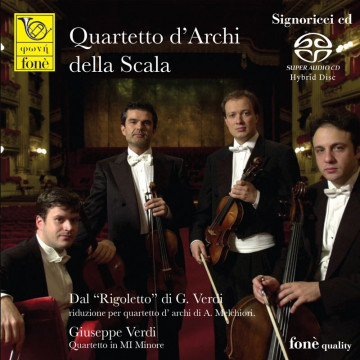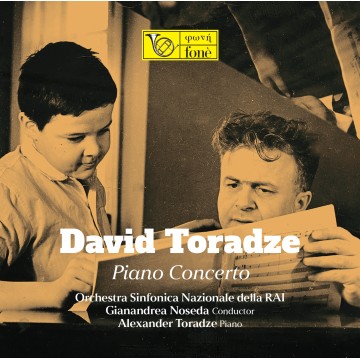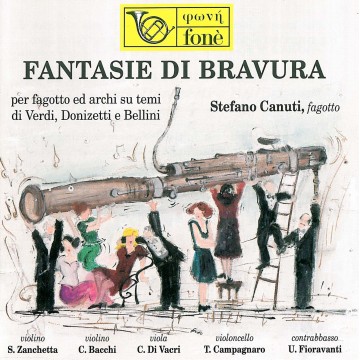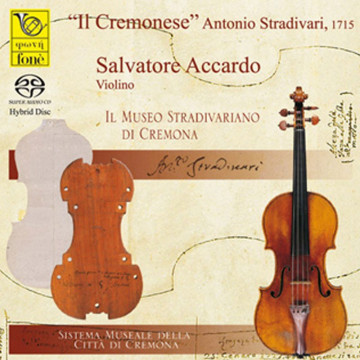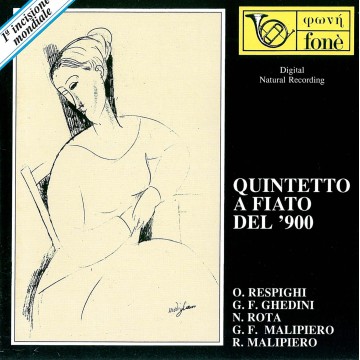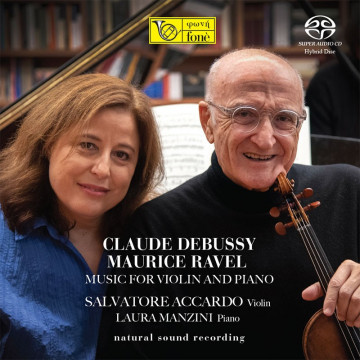- New
"Il Salotto Virtuoso" De Angeli, Giuffredi, Canuti & Fanni (High Resoultion Audio)
[Hi-Res Audio] "Il Salotto Virtuoso"
Giovanni De Angeli, oboe Corrado Giuffredi, clarinet Stefano Canuti, bassoon Umberto Fanni, piano
Konzertstucke in fa minore op. 113 no. 1 per clarinetto fagotto e pianoforte
1. Allegro [2’30”]
2. Andante [3’23”]
3. Presto [2’20”]
F. MENDELSSOHN
Konzertstucke in re minore op. 113 no. 2 per clarinetto fagotto e pianoforte
4. Presto [1’54”]
5. Andante [2’46”]
6. Allegretto grazioso [3’30”]
E. CAVALLINI
7. Adagio e tarantella per clarinetto e pianoforte [5’37”]
A. PONCHIELLI
8. Capriccio per oboe e pianoforte [10’47”]
A. TANSMAN
Sonatina per fagotto e pianoforte
9. Allegro con moto [3’18”]
10. Largo cantabile [2’52”]
11. Scherzo [2’24”]
F. POULENC
Trio per pianoforte, oboe e fagotto
12. Presto [5’20”]
13. Andante [3’27”]
14. Rondò [3’08”]
Durata totale: 54’22”
CREDITS Concept, recorded and produced by Giulio Cesare Ricci
Felix MENDELSSOHN - Konzertstacke Op. 113 e Op. 114 for clarinet, bassoon and piano
Originally composed for clarinet and bassett horn, dedicated to the clarinet players Beyermanns, these are some of Mendelssohn's less important production of "Konzerstiicke": less important not for the musical value, but for a shorter formal structure and for a wide point of view instead of the other works like the Sestetto for string op. 110 (1824) and the young Ottetto op. 20. These brilliant Mendelssohn's Konzertstiicke require from the performers particular virtuosistic and interpretative qualities, mostly in the slow movements of big lirismus and romantic burst.
Ernesto CAVALLINI - Adagio e Tarantella for clarinet and piano
Ernesto Cavallini was the most famous Italian clarinet player of his time; he was for 20 years the first clarinet at "Teatro alla Scala" Orchestra. He was appointed professor at the Conservatoire of Pietroburgo, and first clarinet to the Zar's court. Good performer and excellent interpreter, he inspired Giuseppe Verdi in the famous "solo" in the third act of the Opera "La Forza del Destino". Adagio e Tarantella has a clear operatic quality, and it is part of a large number of virtuosistic compositions dedicated to the clarinet, that Cavallini used to perform in his concerts.
Amilcare PONCHIELLI - Capriccio for oboe and piano
Amilcare Ponchielli, from Cremona, is well known mostly as operas composer and as teacher of Pietro Mascagni and Giacomo Puccini. He lived in a period of great operatic zeal (his contemporary is Verdi, Boito, and Catalani): must not surprise his interest for the instrumental music, which was usual in those days (for example Bellini's Concerto in E major or the Donizetti's Concerto for horn and orchestra, who were his immediate predecessor). Not by chance all three were interested in melancholic instrument whose timbres seems to be closed to the human voice. The Capriccio has many operatic characteristics: the intertwine of elegiac and dramatic motifs but always sustained by a light "cantabile". Finally, the dramatic lyricism of the main theme by Intermezzi and finales, in which the soloist has the opportunity to express all his virtuosity.
Alexandre TANSMAN - Sonatina for bassoon and piano
Polish composer, piano player and conductor, naturalised French, Tansman was friend of Ravel, Milhaud and Honegger. Composed in 1957, the Sonatina for bassoon and piano, is one of a large number of Tansman's compositions for wind instruments. In these works, the wind instruments are played in their most expressive potentiality. In the first movement "Allegro", Tansman gives a "jazz" version, and finished only using the bassoon in a solo recitative form. The following Aria is, certainly, the Sonatina's most inspired moment. The final Presto ("Scherzo"), is otherwise, a real dialogue between the bassoon and the piano
Francis POULENC - Trio for piano, oboe and bassoon
The Trio for piano, oboe and bassoon, composed in 1926 and dedicated to Manuel de Falla, is the first important Poulenc's chamber music work. This Trio begins with a short introduction, dramatic only in the appearance, and continues with a "presto" characterized by an energic music. The "andante" in which the soloists express all the lyricism, is one of the most beautiful Poulenc's pieces: here he shows his deeper poetry, worthy of Franz Schubert. The piano shows the theme elaborated in the following moments from the bassoon and then from the oboe. All the movement is made by an evocative interlace among the three instruments which develop the initial idea. The last movement is a "Rondo molto vivace" and the work, all together, shows an amiable consistency and a stylistic balance. Giovanni De Angeli was born in Turin in 1967. In 1978 began to study at the Conservatoire of Music "G. Verdi" in Turin, where he graduated with full marks in 1985. Subsequently he specialized with Ingo Goritzky at the "Musikhochschiile" in Hannover, and with Maurice Bourgue at the Conservatoire of Geneve. In 1989 he became member, as oboe soloist, of the group "I Solisti Veneti": with them he participated to a numerous tournees, and he performed in the most famous festivals. Recently he won the first prize at the IV edition of the International Competition for oboe in Tokyo. Corrado Giuffredi, first prize at the International Competition "Saverio Mercadante" in Altamura, is considered one of the most interesting young Italian clarinet soloists. Decisive for his musical training have been the meeting with artists like G. Deplus, P. Budini and V. Mariozzi. Already first clarinet of the Symphonyc Orchestra RAI in Turin, since 1991 he plays as a soloist clarinet in the Orchestra "A. Toscanini", which participated with him at tournees in Germany, USA, France and Greece. Stefano Canuti, born in Parma in 1961, began to study bassoon at the age of 17, but his first approach with the music came at the age of 8, thanks to the study of the classic guitar. Under the guidance of Ovidio Danzi he graduated in bassoon with full marks. He obtained his first job with the Orchestra of "Maggio Musicale Fiorentino", in which he ricovered the role of first bassoon for a musical season. In this period, he meets Klaus Thunemann; with him he will study for two years and will start with the soloistic repertoire. In the meanwhile, he played as first bassoon with the RAI Orchestra in Turin. The orchestral experiences will allow him to play with conductors like Metha, Giulini, Pretre, Chung, Maazel. Since 1987 Stefano Canuti devotes himself above all to the soloistic repertoire and at the chamber music. This choice takes him to play all over the world and with musicians like Gallois, Pay, De Peyer, Vernikov and others, and with orchestras like "I Solisti Veneti", "Moskov Virtuosos", "Minneapolis Symphony Orchestra". In 1993 he was invited to Minneapolis and the following year to Bloomington to participate, as soloist, at the "International Double Reed Conference", where he played among others works, an unpublished programme of phantasies from Operas. He is professor of bassoon at the Conservatoire of Music in Castelfranco Veneto. Stefano Canuti plays a FOX bassoon. Umberto Fanni began to study piano with Ludovica Costa Pane at the Conservatoire of music in Cagliari and he got the diploma with full marks and honourable mention at the Conservatoire of Music in Brescia, under the guidance of Agostino Orizio. Later he improved with Harry Datyner at "Conservatoire Superieur du Music" in Geneve. Till now he did lots of concerts by important music associations in Italy and in foreign countries, as soloist as in chamber groups. He participated to a large number of Piano's National and International Competitions, and he won the first prize at "Città di Caserta", at the International Festival of Bardolino and at Festival "Manta 1988". In 1987 he founded, in collaboration with the conductor PiercarloOrizio, the "Giovane Orchestra da Camera Italiana" and he also play in duo with the violinist Stefano Succi; with him he performed for important musical association like "Society dei Concerti" in Milan and for the musical season of the "Ente Teatro Comunale" in Treviso. Umberto Fanni devotes himself also to a constant didactic and organizational activity, and, since 1991, he is assistant for the artistic direction of the famous group of "I Solisti Veneti" conducted by Claudio Scimone. He recorded a large number of registrations for Italian National Television (RAI). He recorded' for the fonè record company and he has already published a CD with music of W. A. Mozart (Concerto in A major K 488 for piano and orchestra).
translated by Ing. Renata Archetti
Data sheet
-
 Native Dsd
Native Dsd
- Visita il sito
-
 Qobuz
Qobuz
- Visita il sito
-
 High Res Audio
High Res Audio
- Visita il sito
-
 iTunes
iTunes
- Visita il sito
-
 Amazon
Amazon
- Visita il sito
-
 7 Digital
7 Digital
- Visita il sito
-
 Tidal
Tidal
- Visita il sito
-
 Deezer
Deezer
- Visita il sito
-
 Spotify
Spotify
- Visita il sito

